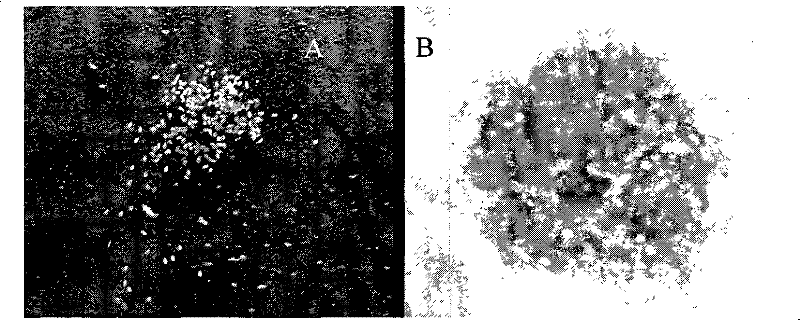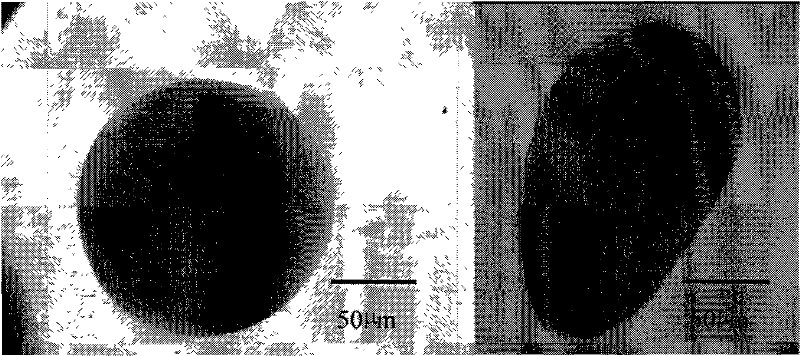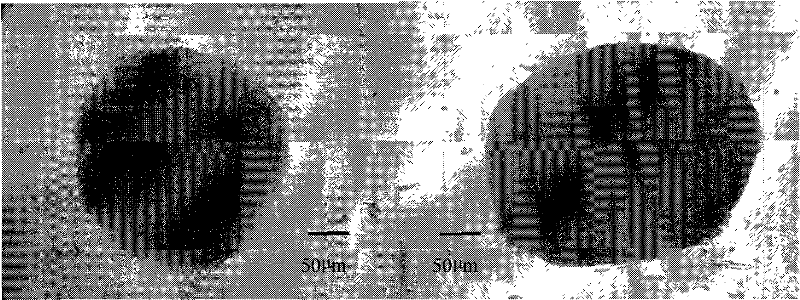Method for artificially collecting and cultivating larva of intertidal belt sponge with embryo
A cultivation method and technology in the intertidal zone, applied in the field of marine biology, can solve problems such as insufficient supply of medicine sources, depletion of sponge resources, ecological environment, destruction, etc., and achieve the effect of simple attachment base selection, wide application prospects, and complete technology
- Summary
- Abstract
- Description
- Claims
- Application Information
AI Technical Summary
Problems solved by technology
Method used
Image
Examples
Embodiment 1
[0032] The luxuriant membranous sponges in Dalian area matured in vivo embryos from September to October in autumn. In September 2006, the tissue pieces of luxuriant membranous sponges with embryos were collected, cleaned and fixed on glass carriers in the laboratory, and kept in 12L glass tanks for 1 day, and then placed in 1L In a glass tank, the air stone is aerated and cultured, the culture water temperature is 22±0.5°C, two conditions of light 5000lx and dark culture are set respectively, and golden algae are fed at a concentration of 2×10 5 / ml. Change the water once a day, and feed twice in the morning and evening. On the first day of cultivation, watch the tide until the larvae are released. The bright orange larvae swim in the water after detaching from the mother body. The size of the larvae is between 200-300 μm. In the experiment, both light and dark cultured mothers can release larvae, and the release time lasts for 17 days, and the number of larvae released is d...
Embodiment 2
[0034] In September 2006, the sponge tissue block with luxuriant embryonic membrane was collected, cleaned in the laboratory, fixed on a glass carrier, and then placed in a 1L glass jar, cultured without light and air stone ventilation, and the water temperature was set at 14±0.5°C, 18± 0.5 ℃ and 25 ± 0.5 ℃ two temperature conditions, feeding golden algae, concentration 2 × 10 5 / ml. Change the water once a day, and feed once in the morning and evening. Investigate the release of larvae. The mothers can release larvae at different temperatures, and the release of larvae was also observed on the first day of the experiment, but the duration and number of larvae released by the mothers at different temperatures were different. 14±0.5°C mothers released larvae for 12 days, and cultured mothers released at 18±0.5°C The larva lasts for 22 days, and lasts for 6 days at 25±0.5°C. See Figure 5 .
[0035] Collect the mother sponge to release the larvae, place them in a 1L or 10L g...
Embodiment 3
[0037] Take the sponge larva attached to the transparent plastic corrugated board for about 14 days, the color is orange, the size is 407.5±79.9 μm, and the temperature when attached is 18±0.5°C. Different combinations of Chrysoflagellates, photosynthetic bacteria, silicon and iron at different concentrations were selected as nutrients and fed to young sponges. The culture temperature is 22±0.5°C and then kept at constant temperature. The size changes of young sponges under different food combinations are shown in Table 1. Young sponges could grow when fed different concentrations of the four nutrients, but with different concentrations, the size of the young sponges changed differently in a short period of time.
[0038] Table 1
[0039] different
PUM
 Login to View More
Login to View More Abstract
Description
Claims
Application Information
 Login to View More
Login to View More - R&D
- Intellectual Property
- Life Sciences
- Materials
- Tech Scout
- Unparalleled Data Quality
- Higher Quality Content
- 60% Fewer Hallucinations
Browse by: Latest US Patents, China's latest patents, Technical Efficacy Thesaurus, Application Domain, Technology Topic, Popular Technical Reports.
© 2025 PatSnap. All rights reserved.Legal|Privacy policy|Modern Slavery Act Transparency Statement|Sitemap|About US| Contact US: help@patsnap.com



